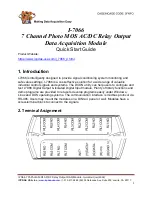
ECB16 ECB18
19
OM-ECB162015006-EN-US
1.
Before starting to operate the truck
(1) be in operating position
(2) disengage clutch on manual transmission-equipped trucks, or apply brake on power
shift or automatic transmission-equipped trucks and electric trucks
(3) place directional controls in neutral
(4) start engine or turn switch of electric trucks to “ON” position
(5) check functioning of lift and tilt systems, load-engaging means and attachments,
steering, warning devices, and brakes
2.
Before leaving the truck:
(1) stop truck
(2) fully lower the load-engaging means
(3) place directional controls in neutral
(4) apply the parking brake
(5) stop the engine or turn off power
(6) turn off the control or ignition circuit
(7) if the truck must be left on an incline, block the wheels
Avoid fire hazards and have fire protection equipment present in the work area. Do not use
open flame to check the level or to check for leakage of any fluid, especially fuel and battery
electrolyte. Do not use open pans of fuel or flammable cleaning fluids for cleaning parts.
Brakes, steering mechanisms, control mechanisms, warning devices, lights, governors, lift
overload devices, guards and safety devices, lift and tilt mechanisms, attachments, articulating
axle stops, and frame members shall be carefully and regularly inspected and maintained in safe
operation condition.
Inspection and Repair of Forks in Service on Fork Lift Trucks
1.
Forks in use shall be inspected at intervals of not more than 12 months (for single shift
operations) or whenever any defect or permanent deformation is detected. Severe
applications will require more frequent inspection.
2.
Individual Load Rating of Forks. When forks are used in pairs (the normal arrangement),
the rated capacity of each fork shall be at least half of the manufacturer’s rated capacity
of the truck, and at the rated load center distance shown on the lift truck nameplate.
Inspection. Fork inspection shall be carried out carefully by trained personnel with the aim of
detecting any damage, failure, deformation, etc., which might impair safe use. Any fork that shows
such a defect shall be withdrawn from service, and shall not be returned to service unless it has
been satisfactorily repaired in accordance with para. Repair and Testing.
1.
Surface Cracks. The fork shall be thoroughly examined visually for cracks and if
https://www.forkliftpdfmanuals.com/
Summary of Contents for ECB16
Page 2: ...https www forkliftpdfmanuals com...
Page 3: ...OPERATOR MANUAL OM ECB162015006 EN US ECB16 ECB18 https www forkliftpdfmanuals com...
Page 9: ...ECB16 ECB18 9 OM ECB162015006 EN US https www forkliftpdfmanuals com...
Page 10: ...https www forkliftpdfmanuals com...
Page 14: ...https www forkliftpdfmanuals com...
Page 33: ...ECB16 ECB18 23 OM ECB162015006 EN US https www forkliftpdfmanuals com...
Page 34: ...https www forkliftpdfmanuals com...
Page 40: ...https www forkliftpdfmanuals com...
Page 48: ...https www forkliftpdfmanuals com...
Page 79: ...ECB16 ECB18 69 OM ECB162015006 EN US https www forkliftpdfmanuals com...
Page 80: ...https www forkliftpdfmanuals com...
Page 86: ...https www forkliftpdfmanuals com...
Page 109: ...ECB16 ECB18 99 OM ECB162015006 EN US https www forkliftpdfmanuals com...
Page 110: ...https www forkliftpdfmanuals com...
Page 115: ...https www forkliftpdfmanuals com...
Page 116: ...OPERATOR MANUAL ECB16 ECB18 https www forkliftpdfmanuals com...
















































